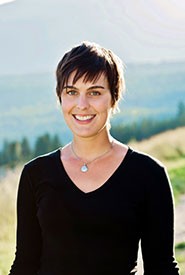Caring for our water is a shared responsibility
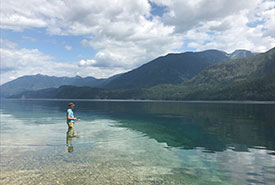
Fishing in the lake (Photo by Natasha Overduin)
My partner and I are in a yellow canoe in the cold, dark water, gliding silently as we skirt the lake’s rocky cliff edge. Our canoe is an old, dented tanker, borrowed from a friend for this three-night camping trip on a large lake in the rugged landscape of BC’s south-central interior.
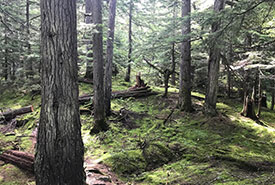
A lush, green forest in BC’s south-central interior. (Photo by Natasha Overduin)
As we paddle along, there’s a palpable sense of strength emanating from the sharply rising mountains, cedar and fir forests and the impossibly clear, deep lake. But at the same time, I feel the vulnerability of this place. Bordered by conservation lands, this lake is one of the few large lakes in the region that’s still relatively undeveloped. Yet, even here, there are a number of threatened fish and amphibian species relying on small but critical areas of vulnerable habitat. Around the lake, shoreline use is increasing, and the highway is encroaching on the north shore. Burned hillsides are a reminder of the fires that ripped through this area in recent summers.
Related content
Right now, though, we try to forget about all that. We’re here to let the water relax and renew us.
I’m lost in the rhythm of my paddling strokes when my partner shouts, “Check it out!” Startled, I look at the cliff rising to my left and see it — strokes made in ochre and white that dance across the rocks. These Indigenous pictographs are bolder than any I have seen elsewhere, immortalized on this rock for generations. As we float past, I feel deep respect for the history of this place.
Over the next few kilometres, I reflect on the stewardship that has long been in place to care for these waters and forests. I ask myself how are our communities, government and industry taking care of fresh water, our most precious natural resource, in today’s world?
With shifting climate and hydrology, and intense cumulative pressures (such as forestry and other industrial uses, increasing shoreline use and up-land development and recreation), we’re entering an era of water insecurity in BC and around the world. Water faces an increasingly uncertain future, and the status quo for managing and governing water must change to reflect these new realities. We must find new ways to work together and to share decision-making responsibilities, especially if we are truly going to reconcile relationships between Indigenous and non-Indigenous Peoples.
But how do we tackle the systemic root issues? And how do we get to better outcomes for water and for Indigenous Nations?
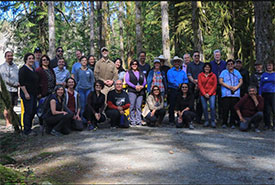
Participants in the Nicola & Cowichan Watershed Learning Exchange, held in Vancouver Island's Cowichan watershed in April 2019. (Photo by Regional District of Nanaimo)
In my work life, I have had the privilege of working face to face with many local collaborative groups, as well as First Nations and governments across BC that are taking on leading roles in water decision-making and management. When I think about the community-driven, on-the-ground work happening in these places, I am encouraged.
In a number of communities, such as the Cowichan watershed on Vancouver Island, collaborative groups are embracing a collaborative or co-governance approach. They’re learning how Indigenous and non-Indigenous neighbours can work shoulder to shoulder to protect local waters and ensure they are fairly managed.
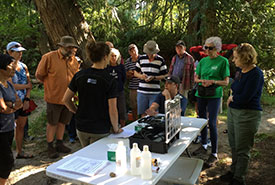
Stewardship volunteers listen to Regional District of Nanaimo staff describe how to use water quality monitoring equipment, at an annual training session to empower community members to collect data on their local creeks and streams as part of the RDN Community Watershed Monitoring Network. (Photo by Regional District of Nanaimo)
In other places, like BC’s Skeena and Nicola regions, Indigenous Nations are working together and driving new water plans and governance processes, and looking at how partnerships can support their progress. Elsewhere, local governments, such as the Regional District of Nanaimo, are stepping up and exploring what kinds of new water initiatives and partnerships they can lead within their scope of responsibility.
Eventually, watershed planning can create a new roadmap and establish improved legal guidelines for decision-making and the sharing of water. With a history of trust and effective engagement in place, groups can even develop truly innovative, new shared decision-making approaches.
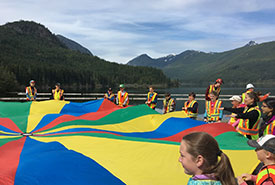
A parachute demonstration helps Grade 4/5 students learn what a watershed is, in the upper Nanaimo River watershed at Jump Lake dam with the RDN, Mosaic Forest Management and the City of Nanaimo. (Photo by Regional District of Nanaimo)
Water reminds of us of our shared humanity and is a place where people can find some common ground. Through real effort and determination, those who live and work in a watershed, with their different (and sometimes conflicting) priorities, needs and opinions, can and must learn how to share the responsibility for keeping our water and lands healthy and resilient.
The lake’s infamous headwind has suddenly picked up and our yellow canoe feels like it’s sitting still in the water. In the distance, we see a bright sliver of yellow beach: our camp for the night. We dig in deep and paddle toward it.

